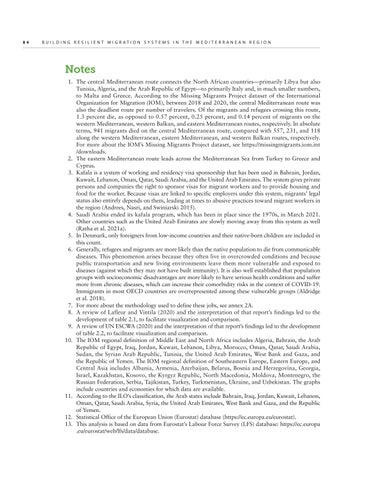84
B U ILDING RESILIENT MIGR A TION S Y STEMS IN T H E MEDITERR A NE A N REGION
Notes 1. The central Mediterranean route connects the North African countries—primarily Libya but also Tunisia, Algeria, and the Arab Republic of Egypt—to primarily Italy and, in much smaller numbers, to Malta and Greece. According to the Missing Migrants Project dataset of the International Organization for Migration (IOM), between 2018 and 2020, the central Mediterranean route was also the deadliest route per number of travelers. Of the migrants and refugees crossing this route, 1.3 percent die, as opposed to 0.57 percent, 0.25 percent, and 0.14 percent of migrants on the western Mediterranean, western Balkan, and eastern Mediterranean routes, respectively. In absolute terms, 941 migrants died on the central Mediterranean route, compared with 557, 231, and 118 along the western Mediterranean, eastern Mediterranean, and western Balkan routes, respectively. For more about the IOM’s Missing Migrants Project dataset, see https://missingmigrants.iom.int /downloads. 2. The eastern Mediterranean route leads across the Mediterranean Sea from Turkey to Greece and Cyprus. 3. Kafala is a system of working and residency visa sponsorship that has been used in Bahrain, Jordan, Kuwait, Lebanon, Oman, Qatar, Saudi Arabia, and the United Arab Emirates. The system gives private persons and companies the right to sponsor visas for migrant workers and to provide housing and food for the worker. Because visas are linked to specific employers under this system, migrants’ legal status also entirely depends on them, leading at times to abusive practices toward migrant workers in the region (Andrees, Nasri, and Swiniarski 2015). 4. Saudi Arabia ended its kafala program, which has been in place since the 1970s, in March 2021. Other countries such as the United Arab Emirates are slowly moving away from this system as well (Ratha et al. 2021a). 5. In Denmark, only foreigners from low-income countries and their native-born children are included in this count. 6. Generally, refugees and migrants are more likely than the native population to die from communicable diseases. This phenomenon arises because they often live in overcrowded conditions and because public transportation and new living environments leave them more vulnerable and exposed to diseases (against which they may not have built immunity). It is also well established that population groups with socioeconomic disadvantages are more likely to have serious health conditions and suffer more from chronic diseases, which can increase their comorbidity risks in the context of COVID-19. Immigrants in most OECD countries are overrepresented among these vulnerable groups (Aldridge et al. 2018). 7. For more about the methodology used to define these jobs, see annex 2A. 8. A review of Lafleur and Vintila (2020) and the interpretation of that report’s findings led to the development of table 2.1, to facilitate visualization and comparison. 9. A review of UN ESCWA (2020) and the interpretation of that report’s findings led to the development of table 2.2, to facilitate visualization and comparison. 10. The IOM regional definition of Middle East and North Africa includes Algeria, Bahrain, the Arab Republic of Egypt, Iraq, Jordan, Kuwait, Lebanon, Libya, Morocco, Oman, Qatar, Saudi Arabia, Sudan, the Syrian Arab Republic, Tunisia, the United Arab Emirates, West Bank and Gaza, and the Republic of Yemen. The IOM regional definition of Southeastern Europe, Eastern Europe, and Central Asia includes Albania, Armenia, Azerbaijan, Belarus, Bosnia and Herzegovina, Georgia, Israel, Kazakhstan, Kosovo, the Kyrgyz Republic, North Macedonia, Moldova, Montenegro, the Russian Federation, Serbia, Tajikistan, Turkey, Turkmenistan, Ukraine, and Uzbekistan. The graphs include countries and economies for which data are available. 11. According to the ILO’s classification, the Arab states include Bahrain, Iraq, Jordan, Kuwait, Lebanon, Oman, Qatar, Saudi Arabia, Syria, the United Arab Emirates, West Bank and Gaza, and the Republic of Yemen. 12. Statistical Office of the European Union (Eurostat) database (https://ec.europa.eu/eurostat). 13. This analysis is based on data from Eurostat’s Labour Force Survey (LFS) database: https://ec.europa .eu/eurostat/web/lfs/data/database.

